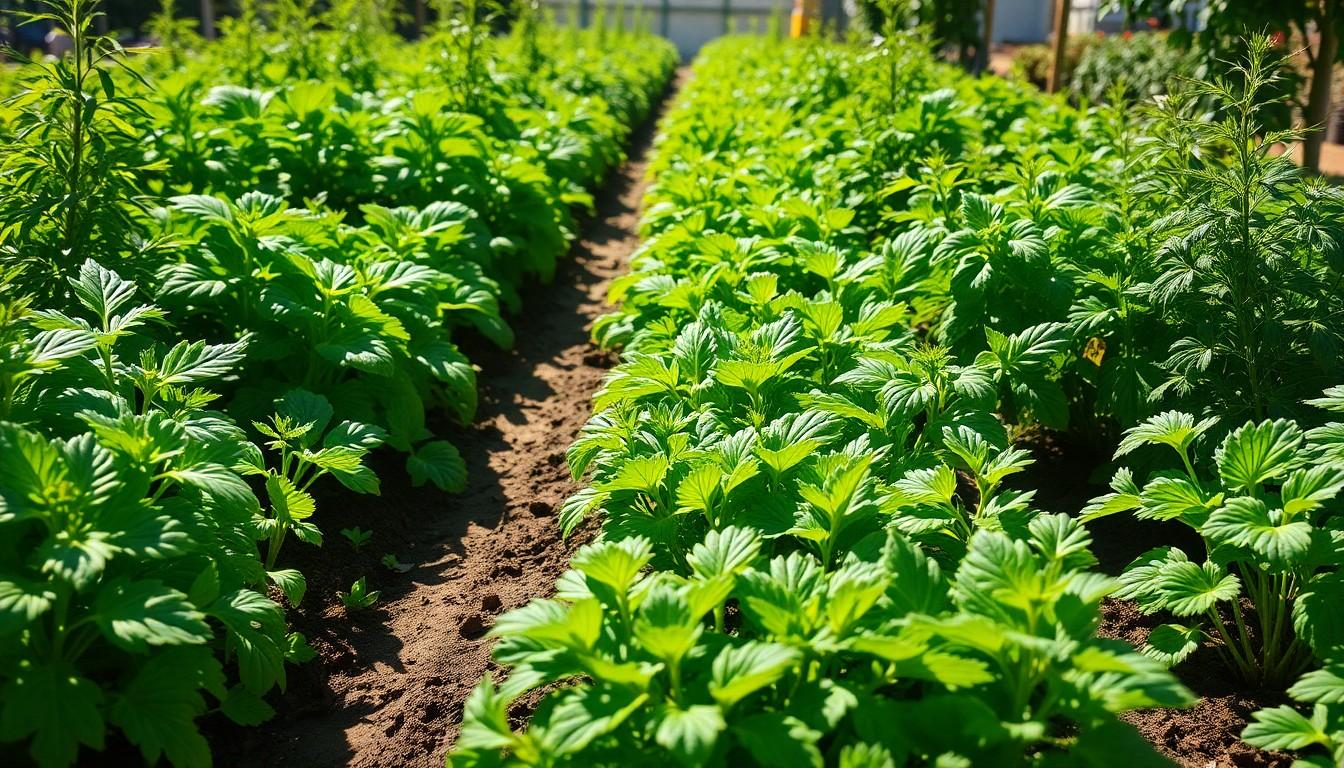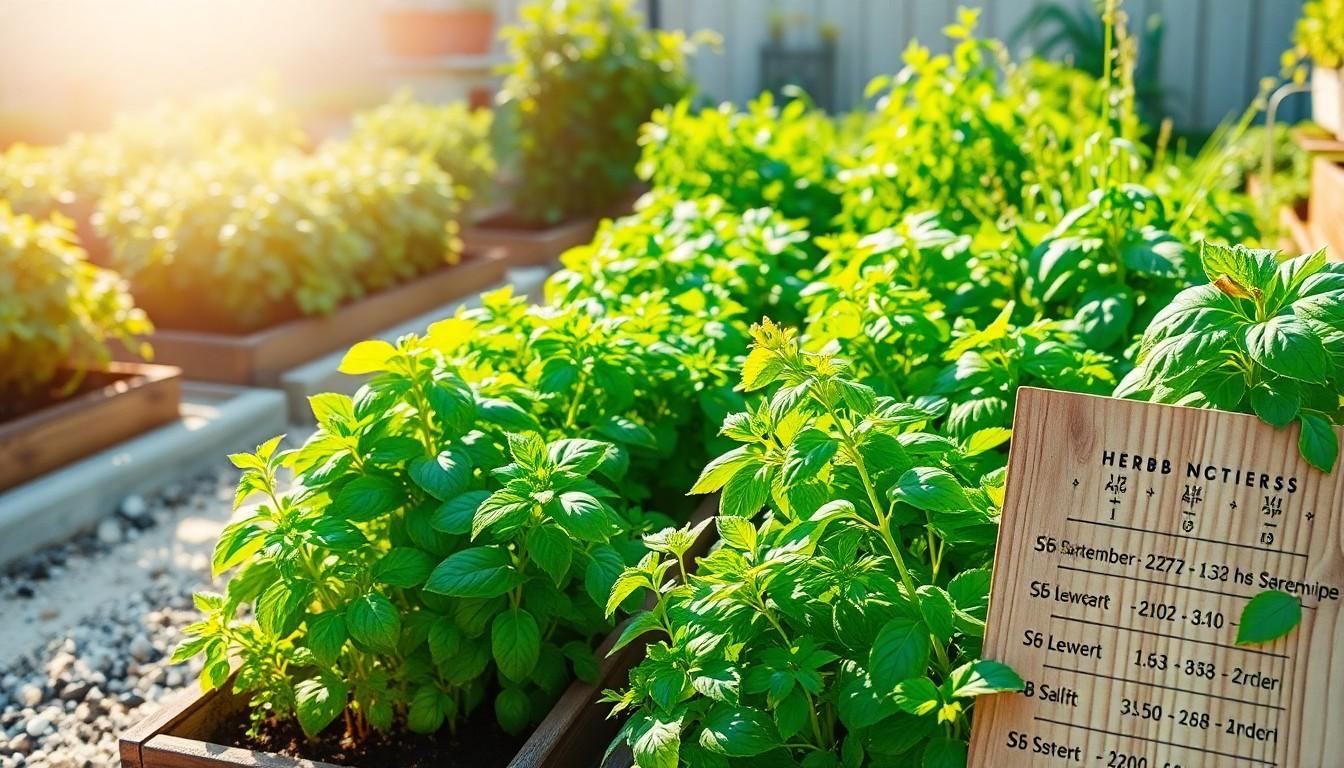Ever thought about turning that little patch of dirt into a thriving herb paradise? With the right herb planting chart, it’s easier than finding a cat video on the internet. Imagine fresh basil for your pasta or mint for that fancy cocktail—your culinary dreams are just a seed away!
herb planting chart
Herb planting charts provide valuable guidance for growers at all skill levels. These visual tools specify optimal planting times, spacing, and companion plants for various herbs. They simplify the process by categorizing herbs into groups based on growth requirements and plant interactions.
In spring, specific herbs thrive when planted after the last frost. Basil, cilantro, and dill commonly perform well in warmer conditions. Mint and chives often establish robust growth when sown in cooler weather. Knowing these details enhances success, as timing directly impacts growth.
Spacing is crucial for healthy herb development. For instance, basil needs 12 to 18 inches between plants, while parsley prefers 10 to 12 inches. Many charts detail these spacing requirements alongside planting depths, allowing for straightforward garden layout planning.
Companion planting is another significant aspect covered in many herb planting charts. When growing herbs like rosemary with carrots, both plants benefit from reduced pest attraction. Additionally, certain herbs such as dill and cilantro repel harmful insects, promoting a healthy garden environment.
Utilizing herb planting charts not only streamlines the planting process but also maximizes yields. Gardeners who reference these charts can successfully cultivate a diverse selection of flavors for culinary use. Engaging with this resource takes the guesswork out of herb gardening, leading to a fresher, more vibrant herb collection for any kitchen.
Benefits of Using an Herb Planting Chart

Utilizing an herb planting chart simplifies the gardening process and enhances the overall experience for both novice and experienced gardeners. This essential tool aids in growing healthy and vibrant herbs.
Improved Planning and Organization
Effective planning occurs when gardeners rely on herb planting charts. These charts outline the ideal planting schedules for various herbs, ensuring individuals plant at the right time. Identifying specific growth conditions becomes easier with explicit details provided about each herb. Gardeners can sequence their planting activities efficiently, reducing overlap and maximizing productivity. Practicing organized gardening leads to greater success in achieving targeted harvests, enhancing the appeal of fresh herbs in culinary endeavors.
Maximizing Space and Yield
Maximizing available space transforms even small gardens into productive areas. Herb planting charts indicate appropriate spacing between different herbs, allowing for optimal growth and air circulation. Calculating the best layout ensures that all herbs thrive without competing for resources. Furthermore, charts often suggest companion planting guidelines, which enhance yields by utilizing space effectively. Understanding growth habits, such as height and spread, allows gardeners to plan strategically, leading to a bountiful collection of herbs throughout the growing season.
Key Factors to Consider
Several critical factors influence the successful growth of herbs. Understanding these elements ensures a flourishing herb garden.
Climate and Growing Zones
Climate plays a vital role in herb growth. Certain herbs thrive in warm climates, such as basil, cilantro, and dill, while others, like mint and chives, prefer cooler temperatures. Knowing the specific growing zone for each herb helps determine optimal planting times. For example, USDA Plant Hardiness Zones classify areas into 13 zones based on average annual minimum temperatures. Gardeners should select herbs suited for their zone to encourage healthy growth.
Soil Requirements
Soil quality significantly affects herb development. Most herbs flourish in well-draining, loamy soil rich in organic matter. pH levels ranging from 6.0 to 7.0 typically yield the best results. Amending soil with compost or well-rotted manure improves fertility and structure. Additionally, regular soil testing helps identify nutrient deficiencies, enabling targeted fertilization strategies that enhance herb growth.
Sunlight and Water Needs
Sunlight and water are essential for herb vitality. Most herbs require at least six hours of direct sunlight daily to produce optimal flavors and aromas. Watering needs vary; shallow-rooted herbs need consistent moisture, while others tolerate dry spells. Gardeners should monitor soil moisture levels, watering deeply when needed to encourage robust root systems. Implementing mulch around herbs also conserves moisture, reducing the frequency of watering while preventing weed growth.
Popular Herb Planting Charts
Herb planting charts serve as essential tools for gardeners interested in cultivating a variety of herbs. They provide guidance on which herbs to plant together and outline optimal growing conditions.
Annual vs. Perennial Herbs
Annual herbs complete their life cycle in one year. Basil, cilantro, and dill thrive as annuals and need replanting each season. In contrast, perennial herbs grow year after year, returning each spring. Examples include mint, chives, and rosemary, which establish deeper root systems. Understanding the difference fosters better garden planning and selection, ensuring gardeners can enjoy fresh herbs throughout the seasons.
Seasonal Planting Recommendations
Planting times vary for each herb throughout the seasons. For spring, start sowing basil, cilantro, and dill after the last frost date. Summer months favor herbs like basil, which thrive in warm temperatures. Fall planting often welcomes hardy varieties such as parsley and chives, suited for the cooler weather. Knowing these seasonal recommendations enhances growth potential, yielding a rich harvest of flavorful herbs.
Tips for Creating Your Own Herb Planting Chart
Creating an herb planting chart involves several key steps that enhance productivity. Start by noting your local growing zone. Understanding this aspect allows for selecting herbs that will thrive in specific climates.
Next, research each herb’s spacing requirements. Different herbs need varying amounts of space to grow healthily, such as basil requiring 12 inches between plants while chives need around 6 inches. This information ensures proper air circulation and minimizes competition for resources.
Consider light and water needs when determining the layout. Most herbs prefer at least six hours of sunlight daily, while their watering requirements differ significantly. For instance, mint thrives with consistent moisture, while oregano prefers drier conditions.
Incorporate companion planting strategies in your chart. Grouping herbs that benefit each other, such as pairing basil with tomatoes, can naturally deter pests and promote growth. This practice not only simplifies maintenance but also increases overall yields.
Finally, schedule planting times based on seasonal recommendations. For example, sow annual herbs like basil and cilantro in the spring while planting perennials like chives and mint can occur in early spring or fall. This scheduling optimizes growth potential throughout the year.
By following these tips, individuals can develop a personalized herb planting chart that supports a thriving herb garden, enhancing culinary experiences with fresh flavors.
rewarding gardening journey
Creating a thriving herb garden is an achievable goal with the right guidance. Utilizing an herb planting chart not only simplifies the process but also enhances the overall gardening experience. By understanding the specific needs of each herb and implementing companion planting techniques, gardeners can cultivate a productive space that yields fresh flavors throughout the season.
Personalizing the chart to accommodate local growing conditions ensures optimal growth and harvest. With careful planning and attention to detail, anyone can transform a small area into a flourishing herb oasis, enriching their culinary adventures with homegrown ingredients. Embracing these strategies opens the door to a rewarding gardening journey.

